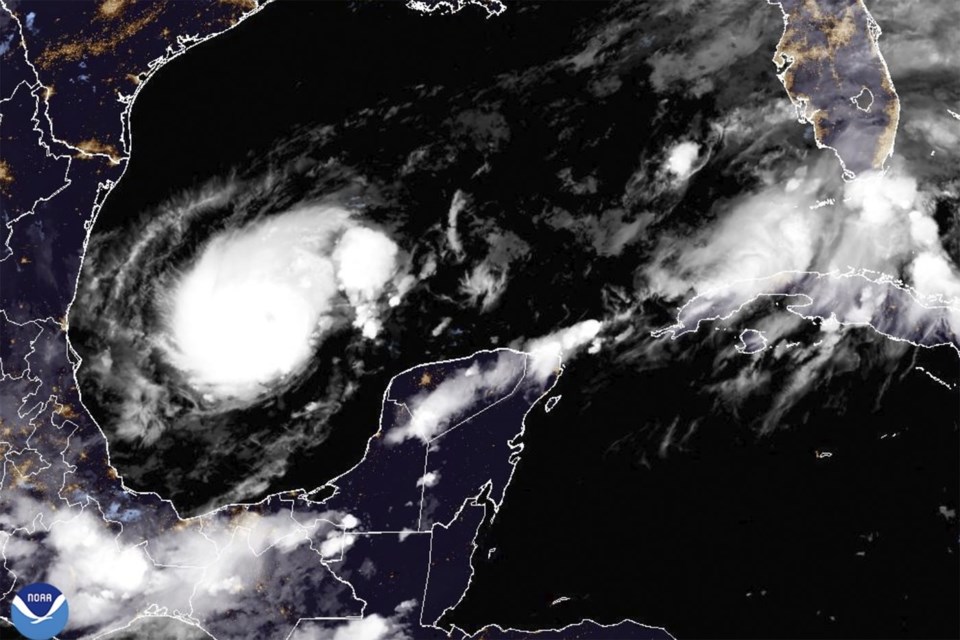Milton rapidly strengthened into a Category 4 hurricane Monday on a path toward Florida population centers including Tampa and Orlando, threatening a dangerous storm surge in Tampa Bay and setting the stage for potential mass evacuations less than two weeks after a catastrophic Hurricane Helene swamped the coastline.
The storm is expected to stay at about its current strength for the next couple of days, the National Hurricane Center in Miami said. Helene was also a Category 4 at landfall in northern Florida. A hurricane warning was issued for parts of Mexico's Yucatan state, and much of Florida's west coast was under hurricane and storm surge watches.
Milton had maximum sustained winds of 150 mph (240 kph) over the southern Gulf of Mexico, the hurricane center said. Its center could come ashore Wednesday in the Tampa Bay area, and it could remain a hurricane as it moves across central Florida toward the Atlantic Ocean. That would largely spare other states ravaged by Helene, which killed at least 230 people on its path from Florida to the Appalachian Mountains.
Forecasters warned of a possible 8- to 12-foot storm surge (2.4 to 3.6 meters) in Tampa Bay and said flash and river flooding could result from 5 to 10 inches (13 to 25 centimeters) of rain in mainland Florida and the Keys, with as much as 15 inches (38 centimeters) in places.
The Tampa Bay area is still cleaning up extensive damage from Helene and its powerful surge. Twelve people perished, with the worst damage along a 20-mile (32-kilometer) string of barrier islands from St. Petersburg to Clearwater.
Florida Gov. Ron DeSantis said Monday that it was imperative that messes from Helene be cleaned up ahead of Milton’s arrival so they don’t become dangerous flying projectiles. More than 300 vehicles picked up debris Sunday but encountered a locked landfill gate when they tried to drop it off. State troopers used a rope tied to a pickup truck and busted it open, DeSantis said.
“We don’t have time for bureaucracy and red tape,” DeSantis said. “We have to get the job done.”
About 7 million people were urged to evacuate Florida in 2017 as Hurricane Irma bore down. The exodus jammed freeways, led to long lines at gas stations and left evacuees in some cases vowing never to evacuate again.
Building on lessons learned during Irma and other previous storms, Florida is staging emergency fuel for gas vehicles and charging stations for electric vehicles along evacuation routes, Kevin Guthrie, executive director of the Florida Division of Emergency Management, said Sunday.
“We are preparing ... for the largest evacuation that we have seen, most likely since 2017, Hurricane Irma,” Guthrie said.
Milton’s center was about 150 miles (240 kilometers) west of Progreso, Mexico, and about 735 miles (1,185 kilometers) southwest of Tampa on Monday morning, moving east-southeast at 8 mph (13 kph), according to the hurricane center.
DeSantis expanded his state of emergency declaration Sunday to 51 counties and said Floridians should prepare for more power outages and disruption, making sure they have a week’s worth of food and water and are ready to hit the road.
On beaches in the St. Pete Beach area, where Helene's storm surge flooded homes and businesses, lifeguards removed beach chairs and other items Monday that could become projectiles in hurricane winds. Schools including the University of Central Florida in Orlando announced they would close in the middle of the week, and Walt Disney World said it was monitoring the hurricane but operating normally for the time being.
All road tolls were suspended in western central Florida. The St. Pete-Clearwater International Airport said it would close after the last flight Tuesday. Hillsborough County, home to Tampa, ordered evacuations for all mobile and manufactured homes by Tuesday night.
All classes and school activities in Pinellas County, home to St. Petersburg, closed preemptively Monday through Wednesday. Officials in Tampa freed all city garages to residents hoping to protect their cars from flooding, including electric vehicles. The vehicles must be left on the third floor or higher in each garage.
The coastal Mexican state of Yucatan announced it was cancelling classes in most towns and cities along the coast, after forecasters predicted Milton would brush the northern part of the state. The cancellations included its most heavily populated Gulf coast cities, like Progreso; the capital, Merida; and the natural protected area of Celestun, known for its flamingoes.
It has been two decades since so many storms crisscrossed Florida in such a short period of time. In 2004, an unprecedented five storms struck Florida within six weeks, including three hurricanes that pummeled central Florida.
Although Tampa hasn’t been hit directly by a hurricane in over a century, other parts of Florida’s Gulf Coast are recovering from such storms in the past two years. The Fort Myers area in southwest Florida is still rebuilding from Hurricane Ian, which caused $112 billion in damage in 2022. Three hurricanes have thrashed Florida’s Big Bend region in just 13 months, including Helene.
Milton is a bit atypical since it formed so far west and is expected to cross the entire southern Gulf, according to Daniel Brown, a hurricane specialist at the center.
“It’s not uncommon to get a hurricane threat in October along the west coast of Florida, but forming all the way in the southwest Gulf and then striking Florida is a little bit more unusual,” Brown said. Most storms that form in October and hit Florida come from the Caribbean, not the southwestern Gulf, he said.
___
Associated Press writers Jeff Martin and Freida Frisaro contributed to this report.
Mike Schneider, The Associated Press



